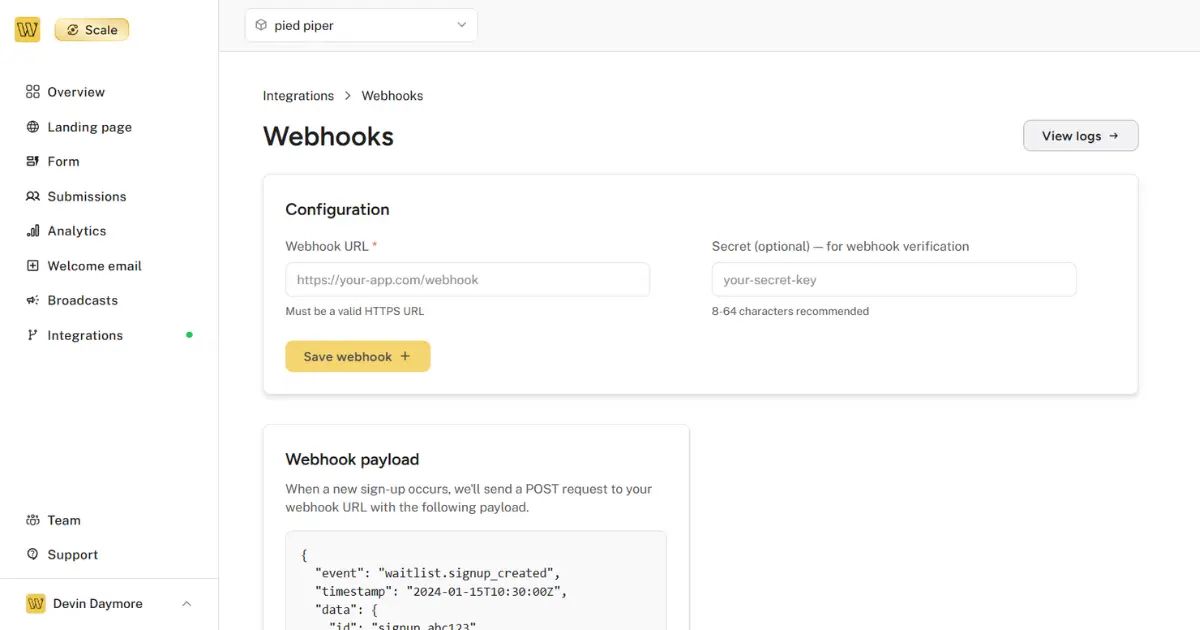Features
Webhooks

Webhooks allow you to receive real-time HTTP notifications for various waitlist events. This enables you to automate workflows, update external systems, and create custom integrations with your favorite tools.
Benefits of Webhooks
Using webhooks with your waitlist provides powerful automation capabilities.
- Real-time Integration: Instantly sync new subscribers to your CRM, email platform, or analytics tools
- Multiple Event Types: Receive notifications for sign-ups, referrals, and milestone achievements
- Custom Workflows: Trigger automated processes like Slack notifications, database updates, or custom logic
- Reliable Delivery: Secure HTTPS delivery with HMAC verification and automatic retry logic
- Complete Data: Receive subscriber information including metadata and referral details
Webhook Events
Waitlister supports three webhook event types that you can enable or disable individually.
New Sign-ups
waitlist.signup_created
Triggered when someone joins your waitlist. Use this to sync subscribers to your CRM, send custom welcome emails, or update analytics.
Referrals Completed
waitlist.referral_completed
Triggered when a subscriber successfully refers someone new. Use this to reward top referrers, send thank-you messages, or track viral growth.
Milestones Reached
waitlist.milestone_reached
Triggered when a subscriber reaches a configurable points threshold. Use this to unlock rewards, grant early access, or celebrate achievements with your community.
Setting Up Webhooks
Configuring Your Webhook
To set up a webhook for your waitlist, follow these steps.
- Navigate to your waitlist dashboard
- Go to "Integrations" in the sidebar navigation
- Click "Manage" on the "Webhooks" card
- Enter your webhook URL and optional secret
- Select which events you want to receive
- Configure milestone thresholds (for milestone events)
- Test your webhook to make sure it's working correctly
Event Configuration
You can enable or disable each event type independently:
- New sign-ups: Always available and enabled by default
- Referrals completed: Enable to track when subscribers refer others
- Milestones reached: Configure point thresholds (default: 100, 200, 300, 500, 1000 points)
You can add up to 10 custom milestone thresholds to match your reward structure.
Webhook URL Requirements
Your webhook endpoint must meet these requirements:
- HTTPS only: All webhook URLs must use secure HTTPS connections
- Fast response: Your endpoint should respond within 15 seconds
- Return 2xx status: Return any 2xx HTTP status code to indicate successful receipt
- Handle retries: Be prepared to receive the same webhook multiple times
Webhook Payloads
New Sign-up Event
{
"event": "waitlist.signup_created",
"timestamp": "2025-01-15T10:30:00Z",
"data": {
"id": "signup_abc123",
"email": "[email protected]",
"name": "John Doe",
"phone": "+1 123 4567",
"position": 42,
"points": 50,
"referral_code": "happy-star-4f3d",
"referred_by": "friend-code-123",
"signup_token": "abc123xyz789token",
"thank_you_url": "https://waitlister.me/thank-you/your-waitlist-key/abc123xyz789token",
"waitlist": {
"key": "your-waitlist-key"
},
"metadata": {
"referring_domain": "google.com",
"user_agent": "Mozilla/5.0...",
"source": "landing-page",
"origin_url": "https://yoursite.com",
"city": "New York",
"region": "NY",
"country": "US",
"timezone": "America/New_York",
"custom_fields": {},
"signup_date": 1642248600000
}
}
}
Referral Completed Event
{
"event": "waitlist.referral_completed",
"timestamp": "2025-01-15T11:45:00Z",
"data": {
"referrer": {
"id": "signup_abc123",
"email": "[email protected]",
"name": "Jane Doe",
"points": 80,
"position": 15,
"total_referrals": 2,
"referral_code": "happy-star-4f3d",
"signup_token": "referrer_token_abc123"
},
"new_signup": {
"id": "signup_xyz789",
"email": "[email protected]",
"name": "Bob Smith",
"referred_by": "happy-star-4f3d",
"signup_token": "newsignup_token_xyz789"
},
"points_earned": 30,
"waitlist": {
"key": "your-waitlist-key"
}
}
}
Milestone Reached Event
{
"event": "waitlist.milestone_reached",
"timestamp": "2025-01-15T12:00:00Z",
"data": {
"subscriber": {
"id": "signup_abc123",
"email": "[email protected]",
"name": "John Doe",
"points": 100,
"previous_points": 85,
"position": 12,
"referral_code": "happy-star-4f3d",
"signup_token": "subscriber_token_def456"
},
"milestone": {
"points": 100,
"reached_at": 1642249200000
},
"waitlist": {
"key": "your-waitlist-key"
}
}
}
Security & Verification
HMAC Signature Verification
For added security, you can configure a webhook secret. When provided, we'll include an HMAC SHA-256 signature in the request headers.
Headers
X-Webhook-Signature: sha256=your-computed-signature
X-Waitlister-Event: waitlist.signup_created | waitlist.referral_completed | waitlist.milestone_reached
X-Waitlister-Delivery: unique-delivery-id
X-Waitlister-Timestamp: 2025-01-15T10:30:00Z
Verification Examples
Node.js
const crypto = require('crypto');
function verifyWebhook(payload, signature, secret) {
const expectedSignature = 'sha256=' +
crypto.createHmac('sha256', secret)
.update(payload, 'utf8')
.digest('hex');
return crypto.timingSafeEqual(
Buffer.from(signature),
Buffer.from(expectedSignature)
);
}
// Usage
const isValid = verifyWebhook(
JSON.stringify(req.body),
req.headers['x-webhook-signature'],
'your-secret'
);
// Handle different event types
const event = req.body.event;
switch (event) {
case 'waitlist.signup_created':
// Handle new sign-up
break;
case 'waitlist.referral_completed':
// Handle referral
break;
case 'waitlist.milestone_reached':
// Handle milestone
break;
}
Python
import hmac
import hashlib
def verify_webhook(payload, signature, secret):
expected_signature = 'sha256=' + hmac.new(
secret.encode('utf-8'),
payload.encode('utf-8'),
hashlib.sha256
).hexdigest()
return hmac.compare_digest(signature, expected_signature)
# Usage
is_valid = verify_webhook(
request.get_data(as_text=True),
request.headers.get('X-Webhook-Signature'),
'your-secret'
)
# Handle different event types
event = request.json.get('event')
if event == 'waitlist.signup_created':
# Handle new sign-up
signup_token = request.json['data']['signup_token']
thank_you_url = request.json['data']['thank_you_url']
elif event == 'waitlist.referral_completed':
# Handle referral
pass
elif event == 'waitlist.milestone_reached':
# Handle milestone
pass
PHP
function verifyWebhook($payload, $signature, $secret) {
$expectedSignature = 'sha256=' . hash_hmac(
'sha256',
$payload,
$secret
);
return hash_equals($signature, $expectedSignature);
}
// Usage
$isValid = verifyWebhook(
file_get_contents('php://input'),
$_SERVER['HTTP_X_WEBHOOK_SIGNATURE'],
'your-secret'
);
// Handle different event types
$event = json_decode($payload)->event;
switch ($event) {
case 'waitlist.signup_created':
// Handle new sign-up
$signupToken = json_decode($payload)->data->signup_token;
$thankYouUrl = json_decode($payload)->data->thank_you_url;
break;
case 'waitlist.referral_completed':
// Handle referral
break;
case 'waitlist.milestone_reached':
// Handle milestone
break;
}
Use Cases
Reward System Automation
Use milestone webhooks to automatically grant rewards when subscribers reach point thresholds:
- 100 points: Send exclusive content via email
- 200 points: Grant early access tier 1
- 500 points: Unlock beta features
- 1000 points: Award VIP status
Referral Campaign Tracking
Use referral webhooks to track and incentivize your top advocates:
- Send thank-you messages after each successful referral
- Award bonus points after 5, 10, or 25 referrals
- Identify power users for special outreach
- Track referral campaign performance in your analytics
Multi-platform Sync
Use sign-up webhooks to keep your systems in sync:
- Add subscribers to your email marketing platform
- Update your CRM with new leads
- Post to Slack when someone joins
- Sync to your data warehouse for analytics
Thank You Page Integration
Use the thank_you_url or signup_token from sign-up webhooks to redirect users or create custom confirmation experiences:
- Redirect users to a custom thank-you page on your domain
- Send personalized confirmation emails with their unique link
- Track conversions with the token as a URL parameter
- Create custom onboarding flows post-signup
- Build subscriber-specific dashboards or portals
Troubleshooting
Common Issues
Webhook not receiving requests
- Verify your URL is publicly accessible and uses HTTPS
- Check your firewall settings allow incoming requests
- Ensure your endpoint returns a 2xx status code
- Verify the event type is enabled in your webhook configuration
Intermittent failures
- Check your server's response time (should be under 15 seconds)
- Verify your endpoint can handle concurrent requests
- Review error logs for specific failure reasons
Signature verification failing
- Ensure you're using the exact secret configured in Waitlister
- Verify you're computing the HMAC using the raw request body
- Check that your secret doesn't contain extra whitespace
Not receiving specific events
- Check that the event type is enabled in your webhook configuration
- For milestone events, verify your milestones are configured correctly
- For referral events, ensure your referral program is enabled
Webhook Status
Webhooks have three possible statuses.
- Active: Webhook is configured and working correctly
- Inactive: Webhook failed its last test or delivery
- Disabled: Webhook was automatically disabled due to repeated failures
Re-enabling Disabled Webhooks
If your webhook was automatically disabled, follow these steps.
- Fix the issue causing failures (check logs for error details)
- Go to webhook configuration page
- Click "Re-enable webhook" in the status warning
- Test the webhook to verify it's working
Help and Support
Need assistance with webhooks? We're here to help.
- Contact us via the public contact form
- Access the "Help" page in your account dashboard
- Check the webhook logs for detailed error information
